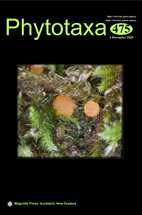Abstract
The type specimens belonging to the genus Aconitum available in Central National Herbarium (CAL) are documented with relevant notes. A total of 92 type specimens belonging to 29 taxa are enlisted, it includes 2 holotypes, 2 isotypes, 1 paratype, 12 lectotypes, 25 isolectotypes, 49 syntypes and 1 original material. Lectotype for seven names, A. bakeri, A. ferox subsp. ferox var. crassicaulis, A. ferox subsp. ferox var. flavidiflora, A. ferox subsp. ferox var. laxiflora, A. gammiei, A. insigne and A. wallichianum have been designated here. Second-step lectotype is also designated here for five names, A. deinorrhizum, A. delavayi, A. jucundum, A. soongaricum and A. transsectum.
References
<p class="Reference">Agnihotri, P., Husain, D. & Husain, T. (2015) Assessment of diversity, endemism and distribution of the genus <em>Aconitum</em> Linnaeus (Ranunculaceae) in India. <em>Pleione</em> 9 (1): 95–102.</p><p class="Reference">Agnihotri, P., Husain, D. & Husain, T. (2016) Aconite from Sikkim Himalaya, India. <em>Current Science</em> 111 (6): 984–985.</p><p class="Reference">Brühl, P.J. (1896) Some new or critical Ranunculaceae from India and adjacent regions. <em>Annals of the Royal Botanic Garden, Calcutta</em> 5: 71–114.</p><p class="Reference">BSI (2020) <em>Central National Herbarium</em>. Botanical Survey of India, Kolkata. Available from: <a href="https://bsi.gov.in/Center/206_7_Central-National-Herbarium.aspx">https://bsi.gov.in/Center/206_7_Central-National-Herbarium.aspx</a> (accessed 23 March 2020)</p><p class="Reference">Chaudhary, L.B. & Rao, R.R. (1998) Notes on the genus <em>Aconitum</em> L. (Ranunculaceae) in North-West Himalaya (India). <em>Feddes Repertorium</em> 109: 527–537.</p><p class="Reference"> <a href="https://doi.org/10.1002/fedr.19981090708">https://doi.org/10.1002/fedr.19981090708</a></p><p class="Reference">Diels, F.L.E. (1912) Plantae Chinenses Forrestianae: account of new and imperfectly known species. <em>Notes from the Royal Botanic Garden, Edinburgh</em> 5: 161–308.</p><p class="Reference">Don, D. (1825) <em>Prodromus florae Nepalensis</em>. J. Gale, London, 256 pp.</p><p class="Reference">Fletcher, H.R. & Lauener, L.A. (1950) Notes on some Chinese species of <em>Aconitum</em> with an enumeration of the Chinese species represented in the Edinburgh Herbarium. <em>Notes from the Royal Botanic Garden Edinburgh</em> 20: 181–206.</p><p class="Reference">Franchet, A. (1886) Plantas Yunnanenses: A Cl. J.M. Delavay collectas. <em>Bulletin de la Societe Botanique de France</em> 33: 358–467.</p><p class="Reference"> <a href="https://doi.org/10.1080/00378941.1886.10828470">https://doi.org/10.1080/00378941.1886.10828470</a> Greene, E.L. (1901) <em>Plantae Bakerianae</em>. Washington, D.C., 145 pp.</p><p class="Reference">Greene, E.L. (1909) Novitates Boreali-Americanae III <em>Repertorium Novarum Specierum Regni Vegetabilis. Centralblatt für Sammlung und Veroffentlichung von Einzeldiagnosen neuer Pflanzen</em> 5: 1–6.</p><p class="Reference"> <a href="https://doi.org/10.1002/fedr.19090070102">https://doi.org/10.1002/fedr.19090070102</a></p><p class="Reference">Kadota, Y. (1999) Systematic studies of Asian <em>Aconitum</em> (Ranunculaceae) V. Notes on <em>Aconitum bulbilliferum</em> and an allied species from Bhutan. <em>The Natural Environmental Science Research</em> 12: 1–9.</p><p class="Reference">Kadota, Y. (2010) Systematic Studies of Asian <em>Aconitum</em> (Ranunculaceae) XIII. Species of Bhutan Including a New Scandent Species. <em>The Journal of Japanese botany</em> 85: 8–24.</p><p class="Reference">Lauener L.A. (1963) <em>Aconitum</em> of the Himalaya. New species and extensions in distribution. <em>Notes from the Royal Botanic Garden Edinburgh</em> 25 (1): 1–30.</p><p class="Reference">Lauener, L.A. (1965) A note on <em>Aconitum leucanthum</em> (Brühl ) Stapf. <em>Notes from the Royal Botanic Garden Edinburgh</em> 26 (3): 331.</p><p class="Reference">Linnaeus, C. (1753) <em>Species plantarum, vol 1</em>. Impensis Laurentii Salvii, Holmiae [Stockholm], 560 pp.</p><p class="Reference">Mabberley, D.J. (2017) <em>Mabberley‘s plant-book: a portable dictionary of plants, their classification and uses. ed. 4.</em> Cambridge University Press.</p><p class="Reference"> <a href="https://doi.org/10.1017/9781316335581">https://doi.org/10.1017/9781316335581</a></p><p class="Reference">McNeill, J. (2014) Holotype specimens and type citations: General issues. <em>Taxon</em> 63 (5): 1112–1113.</p><p class="Reference"> <a href="https://doi.org/10.12705/635.7">https://doi.org/10.12705/635.7</a></p><p class="Reference">McNeill, J., Barrie, F.R., Buck, W.R., Demoulin, V., Greuter, W., Hawksworth, D.L., Herendeen, P.S., Knapp, S., Marhold, K., Prado, J., Prud’Homme Van Reine, W.F., Smith, G.F., Wiersema, J.H. & Turland, N.J. (2012) <em>International Code of Nomenclature for algae, fungi, and plants (Melbourne Code) adopted by the Eighteenth International Botanical Congress Melbourne, Australia, July 2011</em> [Regnum Vegetabile 154]. Gantner, Ruggell, 240 pp.</p><p class="Reference">Mukerjee, S.K. (1959) Central National Herbarium. <em>Bulletin of the Botanical Survey of India</em> 1: 30–32.</p><p class="Reference">Panigrahi, G. (1977) Central National Herbarium (CAL) – past, present and perspectives for the future. <em>Bulletin of the Botanical Survey of India</em> 19: 212–224.</p><p class="Reference">Qureshi, R.A. & Chaudhri, M.N. (1988) The Ranunculaceae of Pakistan. <em>Pakistan systematics</em> 4: 1–224.</p><p class="Reference">Ramamurthy, K. & Samaddar, U.P. (1985) <em>Types of taxa based on Forrest’s collection at CAL. Type collections in the Central National Herbarium</em>. Botanical Survey of India, Howrah, pp. 1–26.</p><p class="Reference">Rau, M.A. (1993) <em>Aconitum </em>L. <em>In</em>: Sharma, B.D., Balakrishnan, N.P., Rao, R.R. & Hajra, P.K. (Eds.) <em>Flora of India</em>, vol. 1. Botanical Survey of India, Calcutta, pp. 3–23.</p><p class="Reference">Reichenbach, H.G.L. (1825) <em>Illustratio Specierum Aconiti Generis, Additis Delphiniis Quibusdam</em>. Friedrich Hofmeister, Leipzig, t. 47.</p><p class="Reference">Reidl, H. (1993) The genus <em>Aconitum</em> in Pakistan and adjacent territories. <em>Linzer biologische Beiträge </em>25 (1): 67–79.</p><p class="Reference">Royle, J.F. (1839) <em>Illustrations of the botany and other branches of the natural history of the Himalayan Mountains and of the flora of Cashmere</em>, vol. 1<em>.</em> H. Allen and Co, London, 472 pp.</p><p class="Reference"> <a href="https://doi.org/10.5962/bhl.title.449">https://doi.org/10.5962/bhl.title.449</a></p><p class="Reference">Samaddar, U.P. (1991) <em>Type collections in the Central National Herbarium</em>, vol. 2. Botanical Survey of India, Howrah, 128 pp.</p><p class="Reference">Sen Gupta, J.C. (1959) Botanical Survey of India: Its past, present and future.<em> Bulletin of the Botanical Survey of India</em> 1: 9–29.</p><p class="Reference">Stapf, O. (1905) The Aconites of India: a monograph. <em>Annals of the Royal Botanic Garden, Calcutta</em> 10 (2): 115–197.</p><p class="Reference">Stapf, O. (1907) <em>Aconitum gammiei</em> Stapf. <em>Bulletin of Miscellaneous Information, Royal Gardens, Kew</em> 1907: 56.</p><p class="Reference"> <a href="https://doi.org/10.2307/4111869">https://doi.org/10.2307/4111869</a></p><p class="Reference">Taylor, G. (1952) Additional notes on plants flown from Bhutan. <em>Journal of the Royal Horticultural Society</em> 77: 237–244.</p><p class="Reference">Tiwary, R., Singh, H., Adhikari, D., Singh, P.P. & Barik, S.K. (2019) A new species of <em>Aconitum</em> (Ranunculaceae) from Eastern Himalaya. <em>Phytotaxa</em> 413 (1): 54–60.</p><p class="Reference"> <a href="https://doi.org/10.11646/phytotaxa.413.1.6">https://doi.org/10.11646/phytotaxa.413.1.6</a></p><p class="Reference">Tiwary, R., Singh, H., Adhikari, D., Singh, P.P. & Barik, S.K. (2020) Discovery of <em>Aconitum haridasanii</em> (Ranunculaceae), a new species from Arunachal Pradesh, India. <em>Phytotaxa</em> 440 (3): 232–238.</p><p class="Reference"> <a href="https://doi.org/10.11646/phytotaxa.440.3.5">https://doi.org/10.11646/phytotaxa.440.3.5</a></p><p class="Reference">Turland, N.J., Wiersema, J.H., Barrie, F.R., Greuter, W., Hawksworth, D.L., Herendeen, P.S., Knapp, S., Kusber, W.-H., Li, D.-Z., Marhold, K., May, T.W., McNeill, J., Monro, A.M., Prado, J., Price, M.J. & Smith, G.F. (Eds.) (2018) <em>International Code of Nomenclature for algae, fungi, and plants (Shenzhen Code) adopted by the Nineteenth International Botanical Congress Shenzhen, China, July 2017</em>. Regnum Vegetabile 159. Koeltz Botanical Books, Glashütten, 254 pp.</p><p class="Reference"> <a href="https://doi.org/10.12705/Code.2018">https://doi.org/10.12705/Code.2018</a></p><p class="Reference">Wang, J.-Y., He, J., Xu, Z.-F., Meng, J., Liu, E.-D. & Wang, H. (2018) <em>Aconitum</em> <em>wumengense</em> (Ranunculaceae), a new species from Yunnan, China. <em>Phytotaxa</em> 343 (1): 60–66.</p><p class="Reference"> <a href="https://doi.org/10.11646/phytotaxa.343.1.5">https://doi.org/10.11646/phytotaxa.343.1.5</a></p><p class="Reference">Yang, Q.E. (1999) Taxonomic notes on some species of <em>Aconitum</em> (Ranunculaceae) from Yunnan, China. <em>Acta Phytotaxonomica Sinica</em> 37: 545–590.</p>

